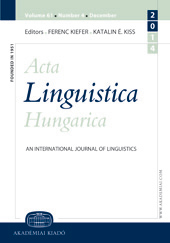Leftward movement with discontinuous appositive constructions
Leftward movement with discontinuous appositive constructions
Author(s): Tanja Milićev, Nataša MilićevićSubject(s): Syntax
Published by: Akadémiai Kiadó
Keywords: discontinuous appositives; leftward movement; coordination;
Summary/Abstract: A rather standard generalization regarding both clausal and nominal appositives to noun phrases is that the appositive element needs to be right adjacent to its antecedent/anchor (cf. Potts 2003). The exceptions to the adjacency requirement are usually restricted to the cases of extraposition (cf. de Vries 2002 for Dutch; Cinque 2006 for Italian). In some languages, however, such as Serbian or Old English, it is possible to split the antecedent and the appositive without resorting to extraposition. Our claim is that in such cases the observed discontinuity is the result of the leftward movement of the antecedent to a higher position in the clause. We discuss the interpretative and syntactic restrictions on this operation, basing our conclusions on the data from Serbian and Old English. We show that the leftward movement account of this phenomenon is not only the most optimal one, but provides a strong argument in favour of treating appositions as specifying conjuncts, as proposed by de Vries (2002; 2006), rather than noun phrase adjuncts.
Journal: Acta Linguistica Hungarica (Since 2017 Acta Linguistica Academica)
- Issue Year: 59/2012
- Issue No: 1-2
- Page Range: 205-220
- Page Count: 16
- Language: English

